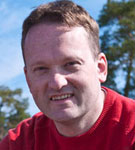 CUDA Spotlight: Erik Lindahl By Andrea Hutchison and Calisa Cole, posted Sept. 27, 2012 GPUs for Molecular DynamicsThis week's spotlight is on Dr. Erik Lindahl of KTH Royal Institute of Technology and Stockholm University. Erik is a project leader for GROMACS, a popular open-source molecular dynamics program. This interview is part of the CUDA Spotlight Series. Q & A with Erik LindahlNVIDIA: Erik, in a nutshell, what is GROMACS? NVIDIA: You have a new release coming up, correct? NVIDIA: Who should consider downloading GROMACS? For a more general audience, I think it is a good concrete example of an exceptionally portable and highly accelerated parallel scientific computing application. In fact, one of our toughest challenges in getting impressive acceleration on NVIDIA cards has been the decade of low-level SSE, AVX and multi-threaded tuning that has gone into the code, and it is only in the last two years that the GPUs are now clearly outperforming even expensive multi-socket CPU nodes for simulations. [Editor's note: To try out GROMACS on a remotely-hosted GPU cluster, see www.nvidia.com/GPUTestDrive] NVIDIA: Tell us about the GROMACS team. Berk is a walking encyclopedia of mathematics and simulation algorithms (not to mention implementations,) but none of us would have been able to accomplish this without Szilárd - it never ceases to amaze me how he refuses to accept "good enough" but always manages to squeeze about another 10, 20, 30, and even 40% performance long after Berk and I think we've reached the limit... I think the unifying motivation for most of us is that we originally started implementing features, parallelization, and acceleration that we needed to accomplish our application work. However, somewhere on the road you suddenly get stuck and realize how fascinating it is to enable computers to do things they have never been able to do before, and then parallel scientific software becomes an amazing adventure. NVIDIA: What are you currently working on, in terms of research? NVIDIA: When did you first learn about GPUs? NVIDIA: What kind of advantages have you achieved with CUDA? In practical terms, CUDA has made it possible for us to go from tweaking code to gain a few percent of improvement on CPUs (which is a lot of money when you use a supercomputer for months!) to getting several hundred percent speed-up. NVIDIA: How did you first get interested in molecular dynamics? NVIDIA: What do you like to do when you are not working? NVIDIA: What is the technological achievement you are most proud of? NVIDIA: What's next in the field of bioinformatics? Instead of testing how a drug binds to a single protein in an experiment it will probably be possible to directly test how it binds to all different genetic mutations and what other molecules it could interact with. This will be a revolution, although I predict we will still use some “wet lab” experiments to confirm the final results. Bio for Dr. Erik LindahlErik Lindahl completed his undergraduate studies in engineering physics at Lund University, after which he received a Ph.D. in theoretical biophysics at the KTH Royal Institute of Technology in Stockholm in 2001. He has performed research at Groningen University, Stanford University, and the Pasteur Institute after which he assumed a position as assistant and later associate professor at Stockholm University in 2004. Since 2010 he has held dual appointments as professor of theoretical biophysics at KTH and professor of computational structural biology at Stockholm University. Since 2011 he has been a member of the Swedish Young Academy. Relevant Links Contact Info |